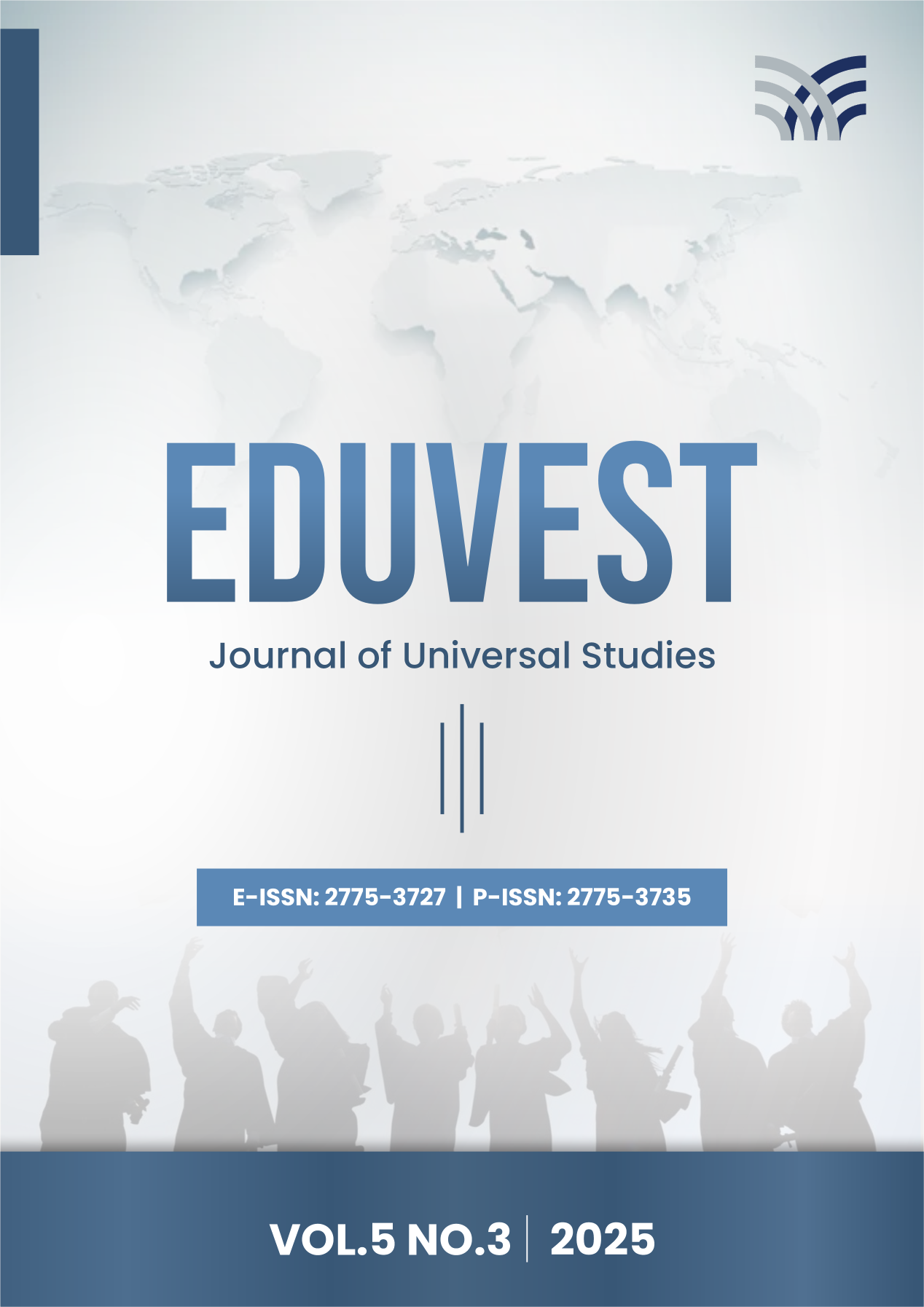The influences of Leader-member exchange (LMX) and perceived organizational support toward performance mediated by organizational commitment of Attorney General's Office of the Republic of Indonesia
DOI:
https://doi.org/10.59188/eduvest.v5i3.50998Keywords:
Leader-Member Exchange, Perceived Organizational Support, Employee Performance, Attorney General’s Office of IndonesiaAbstract
The performance of the Attorney General's Office of the Republic of Indonesia plays a strategic role in supporting national legal development with professionalism and integrity. One crucial aspect of enhancing the prosecutor's office's performance is strengthening competent and competitive human resources (HR). This study aims to analyze the influence of Leader-Member Exchange (LMX) and Perceived Organizational Support (POS) on the Performance of Attorney General’s Office Personnel, with Organizational Commitment as a mediating variable. This research adopts a quantitative approach, collecting data through surveys conducted among Attorney General’s Office employees. The Leader-Member Exchange (LMX) variable refers to the quality of relationships between leaders and subordinates within the organization, while Perceived Organizational Support (POS) describes the extent to which employees feel supported by the institution. Organizational Commitment, as a mediating variable, explains employee attachment to the organization and its impact on individual performance. The findings of this study are expected to contribute to policy development in HR management at the Attorney General’s Office, particularly in improving personnel professionalism, the effectiveness of training programs, and strengthening workplace relationships between leaders and subordinates. The study’s implications can serve as a foundation for designing strategies to enhance competency, accountability, and legal enforcement efficiency.
References
Armstrong, Michael (2014), Armstrong's handbook of human resource management practice 13th Ed, London, Kogan Page.
Chang, W., Liu, A., Wang, X., & Yi, B. (2020). Metaanalysis of outcomes of leader–member exchange in hospitality and tourism: what does the past say about the future? International Journal of Contemporary Hospitality Management, 32(6), 2155–2173. https://doi.org/10.1108/IJCHM0620190591
Che, X., Fakhrorazi, A., Hariani, S., Wei Kit, L., & Foo Wah, L. (2021). The effect of leadermember exchange on task Performance: Evidence from Knowledge Workers in China. The Journal of Asian Finance, Economics and Business, 8(6), 505–514. https://doi.org/10.13106/JAFEB.2021.VOL8.NO6.0505
Chu X, Yu J, Litifu A, Zhao W, Wei X, Wang P and Wei J (2024) Organizational support and task performance:a multiple mediation model. Frontier Psychology.14:1258177.doi: 10.3389/fpsyg.2023.1258177.
GabelShemueli, R. and Riva Zaferson, F.A. (2021), Toward an understanding of the relationship between LMX and performance over time: the role of trust in leader and appraisal satisfaction. Academia Revista Latinoamericana de Administración. Vol. 34 No. 4, pp. 578593. https://doi.org/10.1108/ARLA1220200255
Hanasono, L. K. (2018). Instrument Type SelfReport LeaderMember Exchange 7 Questionnaire (LMX7) Profile 30. In The Sourcebook of Listening Research: Methodology and Measures
Hair, J. F., Risher, J. J., Sarstedt, M., & Ringle, C. M. (2019). When to use and how to report the results of PLS-SEM. In European Business Review (Vol. 31, Issue 1, pp. 2–24). Emerald Group Publishing Ltd.https://doi.org/10.1108/EBR1120180203
Hair, J. F., Hult, G. T. M., Ringle, C. M., Sarstedt, M., Danks, N. P., & Ray, S. (2021). Partial Least Squares Structural Equation Modeling (PLS-SEM) Using R. Springer International Publishing.https://doi.org/10.1007/9783030805197
Hair, J., & Alamer, A. (2022). Partial Least Squares Structural Equation Modeling (PLS-SEM) in second language and education research: Guidelines using an applied example. Research Methods in Applied Linguistics, 1(3). https://doi.org/10.1016/j.rmal.2022.100027
Hair, J. F., Page, M., & Brunsveld, N. (2020). Essentials of business research methods (4th ed.). Routledge. https://doi.org/10.4324/9780429203374
Latifoglu, N., Imamoglu, S. Z., Ince, H., & Altindag, E. (2023). Effect of Leader–Member Exchange on Proactive Employee Behavior and Employee Performance: The Moderating Role of Innovative Climate. Sustainability, 15(20), 14670.https://doi.org/10.3390/su152014670
Lee CC, Li YS, Yeh WC and Yu Z (2022) The effects of leader emotional intelligence, leadership styles, organizational commitment, and trust on job performance in the real estate brokerage industry. Frontier Psychology 13:881725. Team : https://doi.org/10.3389/fpsyg.2022.881725
LópezIbort, N., GonzálezDe la Cuesta, D., AntoñanzasLombarte, T., & GascónCatalán, A. (2020). The correlation between leader–member exchange and organisational commitment among spanish registered nurses: The moderating role of sex and hospital size. International Journal of Environmental Research and Public Health, 17(3). https://doi.org/10.3390/ijerph17030721
Mubarok, E.Saefuddin, (2017), Human Resource Suber Management, Bogor, In Media.
Pattnaik, L., Mishra, S., & Tripathy, S. K. (2023). Perceived Organizational Support and Organizational Commitment: Moderating Role of Person–Organization Fit. Global Business Review, 24(5), 902–915.https://doi.org/10.1177/0972150920920776
Raihan (2017), Research Methodology, Jakarta, Islamic University of Jakarta
Robbins, S. P., & Judge, Tim. (2019). Organizational behavior. Pearson.
Salkind, N. J. (2017). Statistics for people who (think they) hate statistics (7th ed.). Sage Publications.
Shahzad, I. A., Farrukh, M., Kanwal, N., & Sakib, A. (2018). Decisionmaking participation eulogizes probability of behavioral output; job satisfaction, and employee performance (evidence from professionals having low and high levels of perceived organizational support). World Journal of Entrepreneurship, Management and Sustainable Development, 14(3), 321–339.https://doi.org/10.1108/wjemsd0120180006
Sekaran, Uma, & Bougie, Roger. (2016). Research Methods for Business: A Skill-Building Approach. United Kingdom: Wiley.
Silva, P., Moreira, A. C., & Mota, J. (2023). Employees' perception of corporate social responsibility and performance: the mediating roles of job satisfaction, organizational commitment and organizational trust. Journal of Strategy and Management, 16(1), 92–111. https://doi.org/10.1108/JSMA1020210213
Tian G, Liu T and Yang R (2023) Workplace loneliness mediates the relationship between perceived organizational support and job performance : Differing by extraversion. Frontier Psychology 14:1058513 .doi:10.3389/fpsyg.2023.1058513
To, W. M., & Huang, G. (2022). Effects of equity, perceived organizational support and job satisfaction on organizational commitment in Macao's gaming industry. Management Decision, 60(9), 2433–2454.https://doi.org/10.1108/MD1120211447
Vuong, B.N., Tushar, H. and Hossain, S.F.A. (2023), The effect of social support on job performance through organizational commitment and innovative work behavior: does innovative climate matter ?. AsiaPacific Journal of Business Administration, Vol. 15 No. 5, pp. 832854.https://doi.org/10.1108/APJBA0620210256
Wang, C. J. (2022). Exploring the mechanisms linking transformational leadership, Perceived organizational support, creativity, and performance in hospitality: The mediating role of affective organizational commitment. Behavioral Sciences, 12(10). https://doi.org/10.3390/bs12100406
Published
How to Cite
Issue
Section
License
Copyright (c) 2025 Lila Agustina, Aryana Satrya

This work is licensed under a Creative Commons Attribution-ShareAlike 4.0 International License.











